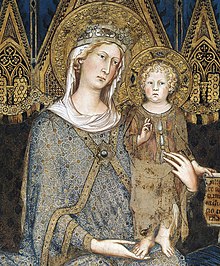
Back Gwerc'hez Vari Breton Birheng Maria CEB Úcta k Panně Marii v katolické církvi Czech Virgen María en la Iglesia católica Spanish Neitsyt Marian kunnioittaminen katolisessa kirkossa Finnish Penghormatan kepada Maria dalam Gereja Katolik ID Venerazione di Maria nella Chiesa cattolica Italian マリア崇敬 Japanese 상경지례 Korean Heshima ya pekee kwa Bikira Maria Swahili
Blessed Virgin Mary | |
|---|---|
 | |
| Mother of God Queen of Heaven Mother of the Church Our Lady | |
| Born | September 8 (Nativity of Mary) |
| Died | The Catholic Church teaches that, at the end of her natural life, she was assumed into heaven, body and soul (Assumption of Mary) |
| Venerated in | Catholic Church |
| Canonized | Pre-Congregation |
| Major shrine | Santa Maria Maggiore, others (see Shrines to the Virgin Mary) |
| Feast | See Marian feast days |
| Attributes | Blue mantle, white veil, Immaculate heart, crown of 12 stars, pregnant woman, halo with 12 stars, roses, woman with child |
| Patronage | See Patronage of the Blessed Virgin Mary |
The veneration of Mary in the Catholic Church encompasses various devotions which include prayer, pious acts, visual arts, poetry, and music devoted to her.[1][2] Popes have encouraged it, while also taking steps to reform some manifestations of it.[note 1] The Holy See has insisted on the importance of distinguishing "true from false devotion, and authentic doctrine from its deformations by excess or defect".[3] There are significantly more titles, feasts, and venerative Marian practices among Roman Catholics than in other Western Christian traditions.[4] The term hyperdulia indicates the special veneration due to Mary, greater than the ordinary dulia for other saints, but utterly unlike the latria due only to God.
Belief in the incarnation of God the Son through Mary is the basis for calling her the Mother of God, which was declared a dogma at the Council of Ephesus in 431. At the Second Vatican Council and in Pope John Paul II's encyclical Redemptoris mater, she is spoken of also as Mother of the Church.[5]
Growth of Roman Catholic veneration of Mary and Mariology has often come not from official declarations, but from Marian writings of the saints, popular devotion, and at times reported Marian apparitions. The Holy See approves only a select few as worthy of belief, the most recent being the 2008 approval of certain apparitions from 1665.[6][7]
Further pious veneration of Mary encouraged by Popes are exhibited in the canonical coronations granted to popular Marian images venerated in a particular locality all over the world, while Marian movements and societies with millions of members have arisen from belief in events such as Guadalupe, Lourdes, Fátima, Akita, and other reasons.[8]
- ^ "Santa Maria". Time. Time Inc. March 27, 1927. Retrieved June 6, 2016.
- ^ Elders, Willem (1994). Symbolic Scores: Studies in the Music of the Renaissance. Symbola et emblemata: studies in Renaissance and baroque symbolism. Vol. 5 (Illustrated ed.). Leiden, Netherlands: E.J. Brill. p. 151. ISBN 978-9004099708. ISSN 0923-9073.
- ^ William, Baum (March 25, 1988). "La Virgen María en la formación intelectual y espiritual" [The Virgin Mary in the Intellectual and Spiritual Formation]. The Holy See (in Spanish). Rome: Congregation for Catholic Education. Retrieved June 6, 2016.
- ^ Flinn, Frank K. (2007). "Mary of Nazareth". In Melton, J. Gordon (ed.). Encyclopedia of Catholicism. Encyclopedia of World Religions. New York: Infobase Publishing. pp. 441–448. ISBN 9780816075652. Retrieved June 6, 2016.
- ^ Cite error: The named reference
RedMaterwas invoked but never defined (see the help page). - ^ "Vatican recognizes Marian apparitions in France". Catholic News Agency. May 5, 2008. Retrieved June 6, 2016.
- ^ Perrella, Salvatore M. (May 8, 2008). "Expert explains Church's criteria for confirming Marian apparitions". Catholic News Agency. Retrieved June 6, 2016.
- ^ Hogan, Robert; Kulkarni, Sumithra (February 7, 2012) [1995]. "Pastoral Marian Organizations in the United States". International Marian Research Institute. The Marian Library/International Marian Research Institute. Retrieved June 6, 2016.
Cite error: There are <ref group=note> tags on this page, but the references will not show without a {{reflist|group=note}} template (see the help page).